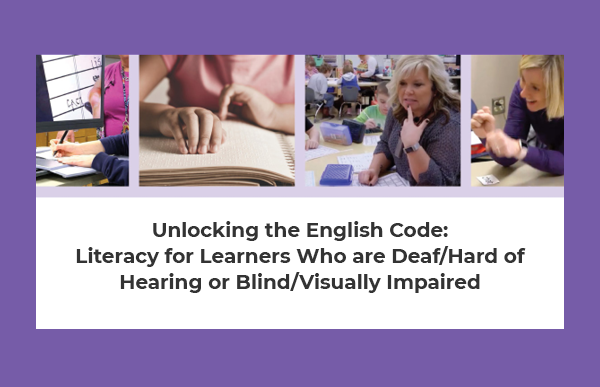Overview

Stacey Tucci and Frances Mary D’Andrea are continuing the learning with another module of Unlocking the English Code. In the previous module, they walked through the essential components of reading instruction, how reading research applies to low incidence populations, and identified adaptations for literacy instruction for students who are deaf/hard of hearing or blind/visually impaired.
This module will take a deeper dive into assessment types and strategies, accessibility and accommodations, and how to use the data that is collected from different assessments during instruction.
Estimated Time to Complete: 2 hours
Learning Objectives:
- Identify types of assessments and how the data from each can be used to drive instruction and intervention.
- Describe the difference between modifications and accommodations within assessments and how to ensure valid and meaningful measurements.
- Name three accommodations to make assessments more accessible for learners who are B/VI.
Presenters
- Frances Mary D’Andrea, Assistant Professor of Practice, University of Pittsburgh. Frances Mary D’Andrea, Ph.D., is an assistant professor of practice at the University of Pittsburgh. Prior to joining the faculty at Pitt, she was an educational consultant specializing in literacy issues for students with visual impairments, and was an adjunct instructor at several U.S. universities. She was a teacher of students with visual impairments in various schools; from 1995-2005, she worked at the American Foundation for the Blind (AFB), and helped establish their National Literacy Center. She is a past-chair of the Braille Authority of North America (BANA); she has served as AFB's representative to BANA since 1998. She is currently secretary of the International Council on English Braille. Dr. D'Andrea has published numerous articles and books, such as serving as co-author of Ashcroft Programmed Instruction in Braille: Unified English Braille, and The Braille Enthusiast's Dictionary. She has conducted numerous workshops and presentations in the US and other countries, and serves on national and international committees related to the education of students with visual impairments.
- Stacey Tucci, Language and Literacy Director, Georgia Department of Education, State Schools Division. Dr. Stacey Tucci’s experiences parenting her Deaf daughter forged the path for her work in the field of Deaf Education. She began her career as an elementary teacher where she taught students using a diverse range of communication modalities including Spoken English, American Sign Language, and sign-supported English. Dr. Tucci received her Bachelor’s in Early Childhood Education and Special Education, her Master’s in Deaf Education, and her Doctorate in the Education of Students with Exceptionalities with a research focus on Intervention Studies for Deaf and hard of hearing (DHH) learners from Georgia State University (GSU). During her time at GSU, Dr. Tucci worked as a Research Associate on two federally-funded Institute of Education Sciences (IES) grants. She has published articles and chapters in research journals, trade/practitioner journals, and textbooks. She is a co-author of and the training director for Foundations for Literacy, an evidence-based, early literacy curriculum for students who are DHH. Dr. Tucci has provided professional learning seminars and conference presentations across the United States as well as Ethiopia, Australia, Taiwan, Greece, France, Canada, and the UK. Dr. Tucci is the Language and Literacy Director at the Georgia Department of Education State Schools Division where she oversees statewide implementation of legislation (OCGA 30-1-5) that ensures all DHH learners are on a path to grade-level reading by the 3rd grade.
Various organizations have approved modules and webinars in the Learning Hub for continuing education credit.